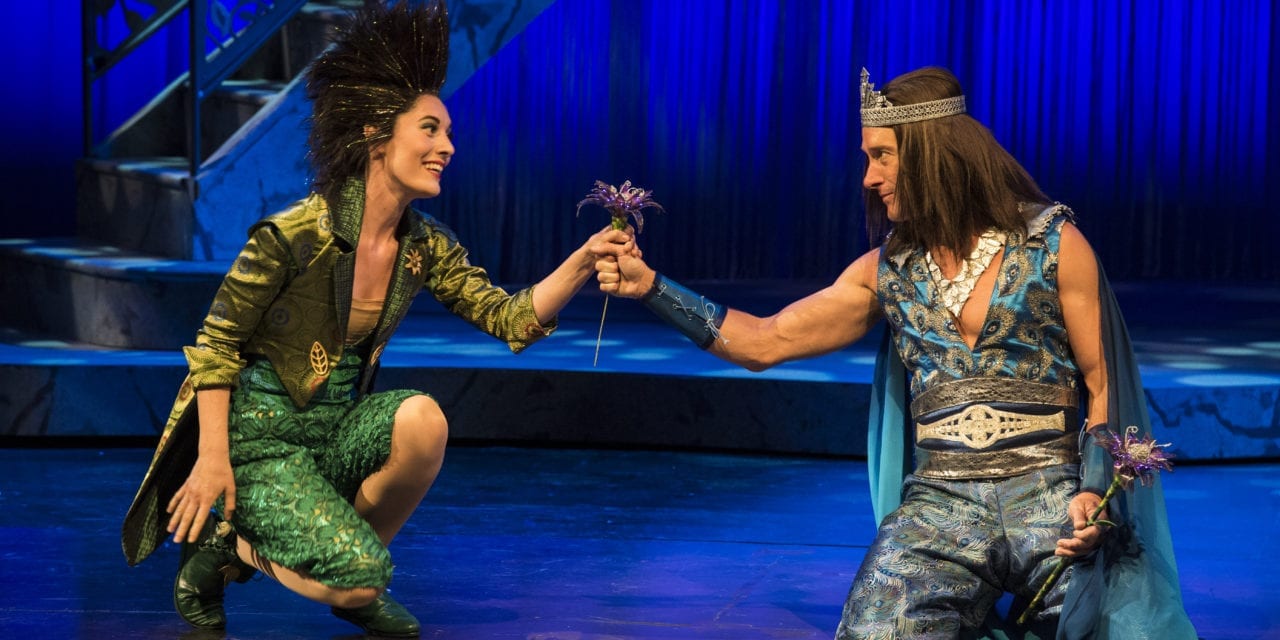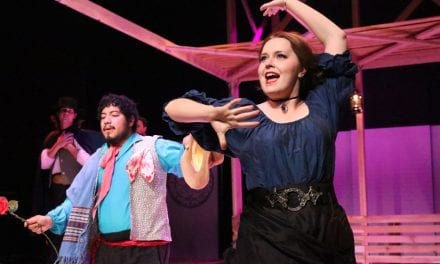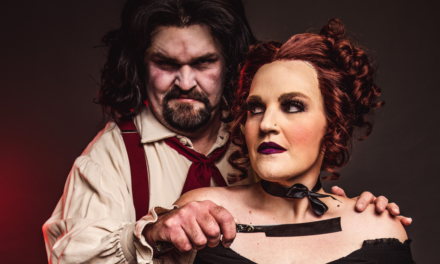CEDAR CITY — With A Midsummer Night’s Dream being the most popular non-musical play in Utah, the challenge for any local company is to strike a careful balance. If a production is too avant-garde, the audience feels alienated; make the show too familiar, and it feels staid and pointless. Impressively, the Utah Shakespeare Festival’s production of A Midsummer Night’s Dream is the perfect mix of innovation and convention with broad appeal for neophytes and Shakespeare veterans.

Show closes October 21, 2017.
One way in which director Kirsten Brandt created a new Midsummer was by injecting a touch of sensuality into the production, such as when Oberton first puts a spell on Titania, or when the mortal lovers partially undressed in the forest. Brandt also enlivened the play by working with Robert Westley (the show’s movement and fight choreographer) to add rhythmic movement to the play, especially for the fairies. I also appreciated how Brandt and Westley made the big argument scene among the mortals more violent than usual, which added to the tension and humor of the famous scene.
This ensemble play benefited from a cast that was so uniformly strong and talented that I am at a loss of which actors to single out in praise. Kelly Rogers was an appropriately impish Puck, and the way she reveled in the mischief and chaos she created was a wonderfully defining trait of her performance. This was best shown in Puck’s childlike glee when the Bottom’s friends were terrified of his transformation. Melinda Parrett was a passionate Titania, which added to the importance of her argument with Oberon over the changling boy. This passion also made her love for Bottom especially humorous, and Parrett embraced the bizarre sensuality that Brandt wanted between Bottom and Titania. J. Todd Adams made Oberon as noble as any human Shakespearean king, and Adams kept the production dignified, even at its zaniest moments.

Kelly Rogers (left) as Puck and J. Todd Adams as Oberon. (Photo by Karl Hugh. Copyright Utah Shakespeare Festival 2017.)
Speaking of zany, no review of A Midsummer Night’s Dream is complete without discussing the “rude mechanicals” who rehearse and perform a play for Theseus and the other Athenian nobles. Of course, they were hilarious, but I also sensed a genuine friendship among the characters. It made sense that these five individuals would spend time together creating a play, and when Bottom was reunited with them, the thrill that swept through the group was almost palpable. James Newcomb‘s performance as Nick Bottom was memorable in the way his character reveled in the fine treatment he received from Titania’s fairy servants and in his eagerness to play a leading role in the play within the play. Finally, given how easily I tire of slapstick, I was surprised at how much I enjoyed the group’s physical comedy, especially the way that Eric Schabla can take a sudden pratfall while playing any role.

A scene from the Utah Shakespeare Festival’s 2017 production of A Midsummer Night’s Dream. (Photo by Karl Hugh. Copyright Utah Shakespeare Festival 2017.)
One notable aspect of the play was how the entire cast handled the poetry of Shakespeare’s script. Every actor who was spoke in verse rendered the rhyme and rhythm of the script beautifully. The four actors playing the mortal lovers were most notable in this regard, especially when Lysander (played by Riley Shanahan) was first falling in love with Helena (played by Cassandra Bissell) and when Hermia (played by Kaitlin Margaret Mills) explains to Helena that she and Lysander are escaping to the forest. Additionally, when Marco Antonio Vega made Demetrius’s denials of love to Helena especially cruel, it made his later change of heart more humorous than is usually seen in Midsummer productions.
One of the many delightful things about this production of A Midsummer Night’s Dream is that it is also lovely to look at. All of the designers created innovative images that made this Midsummer memorable. Brenda Van Der Wiel‘s costumes established an impeccable 1920’s setting, with most of the women dressed as flappers at some point in the play, and the upper class men arrayed in luxurious suits. Once the action shifted to the forest, the costumes had a flair, with the fairies’ costumes incorporating spangles and bright colors that made the setting seem extra fantastical. Accentuating these costumes was Kirk Bookman’s lighting design, which supported the actors as they cast the magical spells by changing whenever the fairies used their power. I also liked the warm glow Bookman gave to the to the morning scene in Act IV, which distinguished the scene from all the turmoil of the previous day.

Riley Shanahan (left) as Lysander, Kaitlin Margaret Mills as Hermia, Cassandra Bissell as Helena, Marco Antonio Vega as Demetrius, and J. Todd Adams as Oberon. (Photo by Karl Hugh. Copyright Utah Shakespeare Festival 2017.)
The set design from Jason Lajka consisted of two pieces: a high false proscenium that was decorated in a green faux marble art deco style for the Athenian palace, and a staircase decorated with plant and animal motifs to represent the forest. The palace set’s imposing vertical lines and sharp angles meshed well with the stern decree from Theseus that Hermia must either marry Demetrius or enter a convent. The forest set, though, was versatile, and the foliage decorations made a traditional set of trees unnecessary.
Yes, the production has aesthetic beauty, talented actors, and a strong directorial vision. But above all else, this production of A Midsummer Night’s Dream is enjoyable. That simple fact is why this play is so popular in Utah and why the Utah Shakespeare Festival’s production is an unqualified success.





